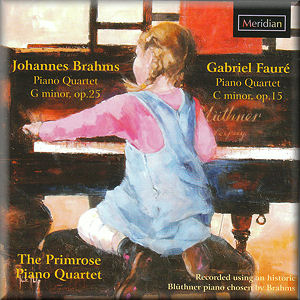 |
 |
|


alternatively
CD: MDT |
Gabriel FAURÉ
(1845-1924)
Piano Quartet No. 1 in C minor, Op.15 (1876-83) [29:48]
Johannes BRAHMS (1933-1897)
Piano Quartet No. 1in G minor, Op.25 (1859-61) [38:20]
 The Primrose Piano Quartet (Susanne Stanzeleit (violin), Robin Ireland
(viola), Andrew Fuller (cello), John Thwaites (piano))
The Primrose Piano Quartet (Susanne Stanzeleit (violin), Robin Ireland
(viola), Andrew Fuller (cello), John Thwaites (piano))
rec. 21-23 September 2010, St. John the Evangelist Church, West
Meon
 MERIDIAN CDE 84599 [68:00]
MERIDIAN CDE 84599 [68:00]
|
|
|
Margarita Hanson from Derbyshire studied music in Germany in
the 1890s. She knew Brahms and, before returning to England,
asked the composer to help her select a piano. It is this instrument,
a Blüthner boudoir grand, which we hear in this recording.
It might seem fitting to play the composer’s music on
the instrument he chose himself, but I have reservations about
this decision. This instrument is old, Brahms chose it for different
purposes, and he probably chose from what was available, which
does not automatically mean the absolute best quality. The disc
pairs two striking piano quartets - arguably the two most striking
in the Romantic repertoire, - but the “wooden” piano
sound and dull acoustics all but kill the enjoyment.
Fauré’s First Piano Quartet has the
characteristic Brahmsian push and edge, yet his German stubbornness
is softened here with sunny French charm. The first movement
is agitated and resolute, with a lyrical, softly opalescent
second subject. The piano is like water, penetrating all layers,
connecting them, oiling and aiding them to move. The development
of the music is masterful and enthralling. The delightful Scherzo
is warm and cool by turns, swiftly flying forward. Its Trio
is more lyrical and songlike, yet with the same unceasing momentum,
like glittering fountain water. The lugubrious slow movement
feels tired and embittered; but then comes an episode of new
hope, poetic and sincere. There is beautiful sadness in these
quiet, resigned pages, which bears resemblance to Tchaikovsky’s
Piano Trio. The finale starts as a distressed, agitated running
through wind and rain. The episodes are shifting: positive and
songlike, exalted and yearning, quiet and cautious, until a
magnificent, passionate melody crystallizes, and all falls back
into the stormy sea. The ending is dense and grandiose; it mixes
everything that was before and concludes the work with a grand
exclamation.
Brahms composed the opening movement of his First Piano
Quartet on a symphonic scale. It is wide-branching, massive
and melodically rich; the colors are dark and cold. It is followed
by a fast and nervous Scherzo, whose doleful tremors are set
off by the suddenly positive Trio, which is happy and quicksilver,
and sounds rather “French”. The slow movement sings
of love and peaceful happiness. Brahms lulls us into a beautiful
dream - and then, without warning, slams us from all the sides
with the first notes of the finale. This incredibly colorful,
fascinating, crazy music is a veritable Gypsy whirlwind. The
listener is caught unprepared by the sharp twists, the episodes
of bravura, mocking seriousness and genuine laughter, then grandiose
and maudlin. Brahms was rarely unbuttoned, but nowhere as much
as here.
The performers choose excellent tempi and play with fire and
passion. Still, the sound is stumbling and uneven, as if scant
of breath. The recording is not clear, reducing the music’s
effect; sometimes I had to strain my ears to hear the inner
voices. In Fauré’s Scherzo we get energetic running
instead of fresh flight, and the pizzicato is not very audible.
The high point in the Fauré is the slow movement, where
the brilliance is less vital. The performance of this movement
is persuasive and deeply felt; the desolate, viscous presentation
enhances the character of the music.
The first movement of the Brahms is very civilized. At some
points the music attains a strange marching quality - mostly
due to the piano playing. What in other performances can seem
to fly forward, here is heard proudly striding. There’s
also constraint in the second movement’s Trio as if running
with legs tied. The strings are expressive in the slow movement,
but the piano is too marcato: it tramples. However, all
works well for the marching middle episode, which comes out
quite effectively. After this the pianist manages to make the
instrument sing, so the last half of the slow movement is played
with powerful intensity. The performance is surprisingly fitting
for the finale. The heavy, wooden footfall of the piano brings
the music closer to its folk roots, with rough stomping and
dashing whistling. The music loses all good manners and shows
itself as impudently rakish. The piano accompaniment is drowning
- and it is good! The musicians play with gusto - right over-the-top.
I really love what they do here.
While I give full marks to the last track, I can’t say
the same for the entire program. Listening to this music should
not be so tiring - I used for comparison the refreshing Fauré
by Domus on Hyperion. The liner-note provides interesting reading
and excellent musical analysis.
Oleg Ledeniov
|
|

